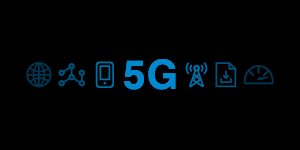Home


Resource Center

5G is poised to replace old wireless benchmarks like 4G LTE, speeding up data transfer and communication speeds. Given its speedier response rates, higher bandwidth, and minimum latency, it’s also expected to facilitate an easier and faster connection of multiple smart devices via the Internet of Things (IoT).
Many consumers and businesses are still waiting to experience the benefits of this next-generation technology firsthand.
The reality is that 5G isn’t widespread yet. Although wireless providers are actively rolling out service, it’s been limited to parts of select cities with minimal coverage relative to the size of the entire nation. If you’re wondering when you’ll have access to 5G, consider these variables:
- Location. Has 5G been rolled out in your city?
- Carrier. Does your carrier have a 5G network in your area?
- Device. Do you have a 5G-enabled smartphone?
If you answered yes to the above questions, you’re probably ready to experience all that 5G technology has to offer. The next step is choosing a 5G network that will work for you.
It’s important to understand that there are variations of 5G, ranging from low-band, mid-band, and high-band, also referred to as millimeter wave (mmWave). Carrier-specific offerings differ depending on which frequency bands are being used to deliver service. This article explains how T-Mobile’s low-band frequency 5G coverage compares to mmWave capabilities.
What Are the 5G Spectrum Bands?
Wireless providers are building their 5G networks to meet all the different needs of their customers. Whether their mobile subscribers live in rural communities or busy metropolitan areas, carriers strive to provide the best coverage possible to businesses and consumers; regardless of where they happen to be located throughout the country.
The FCC licenses spectrum bands to wireless carriers for their 5G networks. High-band, mid-band, and low-band spectrums are categorized as follows:
- High-band (mmWave): 24 GHz and higher
- Mid-band: between 1 GHz to 6 GHz
- Low-band: lower than 1 GHz
Carriers can differentiate their offerings by using a variety of frequencies and bands. For example, T-Mobile owns the licenses to most of band 71 (600 MHz). This low-band sub-6, which refers to frequencies below 6 GHz, performs well over long distances and in rural areas.
Higher frequencies, including 5G mmWave band, are designed for densely populated urban areas. Mobile carriers use a combination of high-band, mid-band, and low-band spectrum to deliver widespread coverage.
What Frequency Is T-Mobile 5G?
In December 2019, T-Mobile launched the first nationwide 5G network and asserted its position as the industry frontrunner. As the nation’s biggest 5G network (covering more than a million square miles in 5,000 towns and cities across the U.S.), the carrier delivers its 5G to more than 200 million mobile subscribers.
Rolling out 5G on its low-band 600 MHz frequency spectrum, T-Mobile outlined several benefits of its new network, emphasizing how it:
- Goes farther and deeper than competitors’ 5G networks
- Provides widespread coverage over hundreds of square miles
- Works outdoors and indoors, penetrating walls, terrain, and other obstacles
When compared to high-band 5G, however, T-Mobile’s data speeds aren’t nearly as fast as mmWave. In recent testing, the carrier’s low-band 5G download speeds were similar to its 4G LTE speeds, about 34 Mbps, and significantly slower than Verizon’s mmWave 5G.
5G mmWave vs. sub-6 GHz
In contrast to low-band sub-6 frequencies, mmWave delivers ultra-fast data speeds as high as 5 Gbps. The high-band frequency also has greater bandwidth and the capability of transmitting more data in densely populated urban areas.
However, unlike low-band frequencies that work well in rural areas, mmWave requires a large number of cell towers in close proximity. Given this limitation, it’s ideal in high-traffic environments where lots of people congregate, such as sports stadiums, campuses, arenas, convention centers, and other large venues.
Low-band sub-6 5G works well in low-traffic rural locations where mobile subscribers aren’t always near a cell tower. It also provides better indoor and outdoor coverage because of its ability to penetrate walls, terrain, and other obstacles better than mmWave.
What are 5G mmWave challenges?
Operating in the 30-300 GHz spectrum band, mmWave 5G delivers lightning-fast speeds and has greater bandwidth than sub-6 5G. However, several factors can contribute to transmission loss and limited signal range. The following list of obstacles can impede mmWave signal:
- Weather. Higher frequencies are more susceptible to rain, water vapors, and other atmospheric conditions.
- Terrain. Trees, foliage, and other vegetation can obstruct signals.
- Buildings. Construction materials, including concrete, steel, brick, and energy efficient glass, can block signal.
Although mmWave has large bandwidth potential and low latency, frequency range is limited to approximately one mile. In urban areas, those same high-band spectrum signals can only travel about one city block. These are some of the challenges that wireless networks currently face with mmWave in 5G mobile communication.
Read about the new CBRS technology here.
Your Future with 5G
As wireless providers continue to build their 5G networks and differentiate their service offerings, businesses and consumers are becoming more familiar with the advantages of 5G technology.
Almost every industry, from healthcare and financial services to public safety, retail, and education, will benefit from 5G. As you educate yourself about 5G variations, you’ll be able to make an informed decision about what 5G network is right for you and your business.
The Pro 710i 5G cellular repeater utilizes Band 71 (600 MHz) frequency to enhance in-building connectivity. Our 5G solutions allow visitors, employees, customers, and tenants of your building to take advantage of powerful 5G technology.
Contact us to learn how WilsonPro can help you with your cell coverage issues today.

